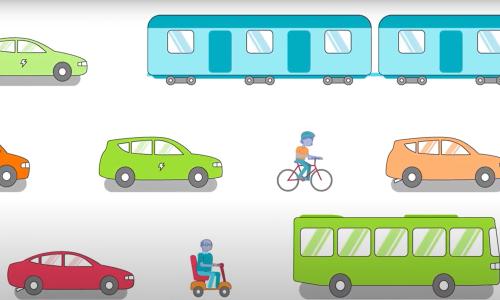Recent studies of the impact that land conversion has on the global warming pollution created by crop-based biofuels are changing the science of measuring biofuel risks and rewards. These studies demonstrate that when crop-based biofuels contribute to deforestation or other damaging land conversions, the pollution benefits can be compromised or even eliminated, potentially producing a net increase in pollution. The science behind these calculations is new, and the numbers can be expected to change as the science matures, but we can already conclude that biofuels must use both land and energy efficiently to ensure these fuels play a constructive role in addressing global warming.
Some biofuels can be produced without harmful changes in land use, and these have great potential to reduce global warming pollution. Examples include fuels made from biomass waste products or native perennials grown on land not currently used for or well suited to food crops. On the other hand, there are types of land that should certainly not be used for biofuel production, especially forests high in stored carbon and rich in biodiversity. Converting a forest to cropland can result in much more global warming pollution than the amount that can be reduced by the biofuels grown on that land.
The science of land-use changes
A recent paper estimated that if peatlands in Southeast Asia were converted to palm oil plantations to make biodiesel, it would take 423 years to pay back the “carbon debt” from the land-use change. (1)
In the United States today, biofuels are mainly produced from corn and soybeans grown on existing agricultural land, so there is not necessarily a direct land-use change. But there can be an indirect land-use effect when the corn and soy are taken out of the market for food and animal feed. (2) This increases corn and soy prices, stimulating land conversion in other parts of the world. A study by Searchinger et al. of this indirect effect used agricultural economics models to estimate how global markets respond to the increased use of corn for biofuels. (3) They used these models and historical data on land conversion to estimate where new crops will be planted, what land will be converted, and what emissions will result. Based on these estimates they calculated that expanded use of corn ethanol will produce almost twice as much global warming pollution as gasoline.
The federal energy bill passed in 2007 includes a Renewable Fuel Standard (RFS) that significantly accelerates use of biofuels including ethanol—from about 6 billion gallons in 2007 to 36 billion gallons in 2022. The RFS requires most renewable fuels to reduce global warming pollution, including pollution from indirect land conversion, but exempts corn ethanol produced in existing plants or plants that were under construction prior to the law’s enactment. This loophole undermines the standard’s intended benefits. If the estimates of indirect land-use impacts by Searchinger et al. are accurate, the emissions from roughly 12 billion gallons of corn ethanol exempt from pollution limits set by the RFS could wipe out the benefits derived from the remaining 24 billion gallons of renewable fuels over the lifetime of the RFS. (4)
A sensible approach to biofuel production
The Union of Concerned Scientists’ Principles for Bioenergy Development suggest how biofuels and bioenergy can be a productive part of a broader strategy to address climate change. Below, we offer additional recommendations that address land-use issues specifically and suggest how to avoid harmful unintended consequences, which can prevent biofuels from achieving their potential.
Performance-based policies should reward reductions in global warming pollution over a fuel’s full life cycle, based on the best available information and vetted in an open and transparent process. The rule making currently under way for the federal RFS and the California low-carbon fuel standard (LCFS) will determine how global warming pollution is measured for compliance with these standards; their success requires that all significant inputs and impacts, including indirect land-use changes, be considered. Because the science of global warming pollution and indirect effects is still evolving, and new studies will improve our understanding over time, both standards must also include a mechanism to ensure that life cycle emissions metrics used for compliance can be improved accordingly, and that the process is open, transparent, and based on the best peer-reviewed science.
Biofuel life cycle analysis should include a non-zero estimate, based on the best available science, of emissions associated with indirect land-use changes. While there is no scientific consensus about the exact magnitude of indirect land-use effects, and details of the methodology used to measure these effects are debated, scientists generally agree that the impact is real and significant. Because the federal RFS and California LCFS will be implemented before a firm consensus on these details can be reached, both standards should take effect with a non-zero default value. The U.S. Environmental Protection Agency and the California Air Resources Board are developing models fundamentally similar to Searchinger et al. in their use of global economic agricultural models; both agencies should use their best estimates and set a schedule for updating them as the science improves. Even an indirect land-use value of one-fourth that predicted by Searchinger et al. could have significant implications for near-term policy decisions, and setting that value to zero will send the wrong signal.
The United States should promote biofuels that use both land and energy efficiently. Current life cycle accounting does a good job accounting for a fuel’s energy inputs, but the recent literature suggests we have not accounted for land use adequately. In spite of the uncertainty, however, we can state with relative certainty that biofuels that use land more efficiently, such as those derived from agricultural, forest-product, and municipal waste streams, are a better bet than food-based biofuels from a land-use perspective. And bioenergy crops that improve land currently considered unsuitable for agriculture are likely to be the best bet of all. While these resources appear beneficial from a climate perspective, their broader impact must be considered before moving forward with their use, as outlined in the UCS Principles for Bioenergy Development.
Additional funding should be directed to areas of research that can improve our ability to measure land-use changes globally. Satellite and aerial imagery, for example, can be used to accurately and objectively measure changes in land use and estimate the impact on carbon cycling, nitrogen and methane cycling, and carbon sequestration. Also, economic modeling of the impact biofuel production will have on land-use decisions worldwide (and how this affects food prices and availability, global warming pollution, deforestation, nutrient runoff, water use, and other important outcomes) will be critical to biofuel life cycle accounting and climate policy in general.
A long-term commitment to biofuels must be tempered by realistic expectations about the scope of biomass production. Biofuels derived from many resources can play a role in reducing global warming pollution. The federal RFS calls for 21 billion gallons of advanced ethanol, which would require about 300 million tons of biomass. Based on current estimates, this amount of biomass can be obtained from waste products such as agricultural residues, forestry residues, and municipal and construction waste.5 Any significant expansion beyond this level, however, must be based on a sound scientific determination that the required volume of biomass can be produced in a sustainable manner. Biofuels will have to compete for biomass with electrical power generation, biogas and chemical production, and traditional agricultural uses such as food, feed, and fiber. Unexploited biomass production systems such as forests and prairies also play an important role in supporting needed ecosystem services including water purification, carbon sequestration, nutrient cycling, biodiversity, and recreation. If we over-utilize these resources to make fuel, we risk transforming a potential solution to our fuel challenges into a major problem for food supplies and ecosystem services. We need to ensure that renewable resource policies account for this risk and strike the right balance.
Notes
- Fargione, J., et al. 2008. Land clearing and the biofuel carbon debt. Science 319(5867):1235–1238.
- Some by-products of ethanol production can be used as animal feed and therefore replace some of the corn and soy used for fuel. This displacement is accounted for in the life cycle analysis.
- Searchinger, T., et al. 2008. Use of U.S. croplands for biofuels increases greenhouse gases through emissions from land-use change. Science 319(5867):1238–1240.
- For more information, see: UCS. The 2007 Renewable Fuel Standard.
- Perlack, R.D., L.L. Wright, A.F. Turhollow, R.L. Graham, B.J. Stokes, and D.C. Erbach. 2005. Biomass as feedstock for a bioenergy and bioproducts industry: The technical feasibility of a billion-ton annual supply. TM-2005-66. Oak Ridge, TN: Oak Ridge National Laboratory, U.S. Department of Energy.



